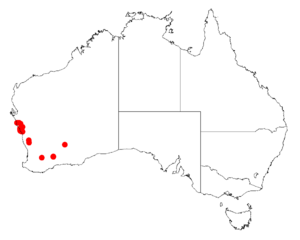Acacia oxyclada facts for kids
Quick facts for kids Acacia oxyclada |
|
|---|---|
| Scientific classification | |
| Genus: |
Acacia
|
| Species: |
oxyclada
|
 |
|
| Occurrence data from AVH | |
Acacia oxyclada is a special type of shrub that belongs to the Acacia family, also known as wattles. This plant is found only in western Australia, meaning it is endemic there. It's a unique part of Australia's natural plant life.
Contents
What Does Acacia oxyclada Look Like?
This shrub usually grows to be about 0.1 to 1.0 meter (which is about 0.3 to 3.3 feet) tall. It can spread out or grow straight up. Its branches are short and pointy, like tiny spines, and they don't have hairs (they are glabrous).
Like many Acacia plants, Acacia oxyclada doesn't have regular leaves. Instead, it has what are called phyllodes. These are flattened leaf stalks that look and act like leaves. The phyllodes of this plant are always green and stand upright. They are shaped like narrow rectangles, about 7 to 13 millimeters long (0.28 to 0.51 inches) and 1 to 1.5 millimeters wide (0.04 to 0.06 inches). They are smooth or nearly smooth.
Flowers and Seed Pods
Acacia oxyclada blooms from August to October, showing off its bright yellow flowers. These flowers grow in small, round clusters called flower-heads. Each flower-head is shaped like a small ball and contains 20 to 25 golden flowers.
After the flowers bloom, seed pods start to form. These pods are smooth and thin, like paper (this is called chartaceous). They can be straight or slightly curved, growing up to 5 centimeters (about 2 inches) long and 3 to 4 millimeters (about 0.12 to 0.16 inches) wide. Inside the pods are shiny, oval-shaped seeds. Each seed is about 2 to 2.5 millimeters (0.08 to 0.1 inches) long and has a special fleshy attachment called an aril, which is as long as the seed itself.
How Was Acacia oxyclada Named?
This plant was first officially described by a botanist named George Bentham in 1864. A botanist is a scientist who studies plants. He included the description in his important work called Flora Australiensis.
Later, in 2003, another botanist named Leslie Pedley reclassified it. He moved it to a different group, calling it Racosperma oxycladum. However, in 2006, it was moved back to the Acacia group. Sometimes, people confuse Acacia oxyclada with another similar plant called Acacia ulicina.
Where Does Acacia oxyclada Grow?
Acacia oxyclada is found naturally in specific areas of Western Australia. These areas include the Mid West and Wheatbelt regions. It likes to grow on sandy plains and rocky hills. You can often find it in sandy or clay-like soils that contain a lot of iron (these are called lateritic soils).
This plant has a disjunct distribution, which means its populations are spread out and not continuous. The main group of these plants grows from around Northampton in the north down to Kalbarri in the south. There are also smaller groups found near Moora and Lake Varley. It often grows as part of low shrubland communities, alongside other Acacia species and Melaleuca plants.

